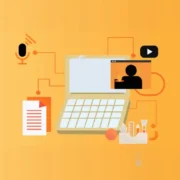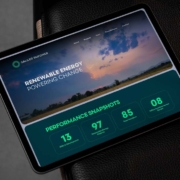The Story of Us
Digital Accessibility Guide

With just over a week until the European Accessibility Act (EAA) becomes enforceable on June 28th, 2025, small and medium-sized enterprises (SMEs) across Ireland are being called to act. Digital accessibility is no longer just a best practice, it’s a legal requirement.
Digital Business Ireland research also found that nearly half (49%) of Irish businesses remain unaware of the requirements of the Act, and do not believe they will be compliant with it in time. If your business is one of the ones not prepared, achieving accessibility compliance may seem to be overwhelming. We have created a step-by-step checklist that SMEs can follow in order to be ready and achieve compliance with the EAA.
But what exactly is digital accessibility?
Digital Accessibility
Digital accessibility refers to the design of websites, mobile apps, and digital services that can be used by people with a range of disabilities: including hearing, visual, cognitive, and physical impairments.
It’s about inclusivity. It’s about making sure that no one is left out of the digital conversation. And now, it’s about legal compliance too.
From June 28th, the EAA mandates that businesses must ensure all digital platforms are accessible to everyone. That includes everything from ATMs and smartphones to e-commerce sites and banking apps.
With penalties of up to €60,000, or worse, personal liability, it’s time to take this seriously.

The Business Case: Why it Matters
Beyond the legal imperative, there’s a human and economic one.
According to the Disability Federation of Ireland, more than 1 in 5 Irish citizens live with a long-term disability. For many, digital accessibility is not a convenience, it’s their only option.
This means accessible design is not just ethical; it’s smart business. Prioritising accessibility helps SMEs tap into a broader market, enhance user experience, and gain a competitive edge.
By embedding accessibility into your digital footprint, you make your brand more inclusive, more trustworthy, and ultimately, more successful.
The POUR Principles
Accessibility is grounded in four simple but powerful principles:
- Perceivable: Content must be visible and understandable. Use alt text, captions, transcripts, and strong colour contrast.
- Operable: Navigation should be simple. Enable keyboard-only use, avoid time-restricted tasks, and keep interaction stress-free.
- Understandable: Keep language plain and consistent. Provide clear instructions and intuitive layout.
- Robust: Design for all devices and assistive technologies. Use structured HTML, and keep updating your site to remain compatible.

A Practical Roadmap for SMEs
Digital accessibility may seem overwhelming, but it doesn’t have to be. Here’s a four-step plan to guide your journey:
1. Assess Your Current State
First Steps: How Do You Know If You’re Accessible?
Begin by having a quick overview of your current state of accessibility. The easiest way is to perform a little accessibility testing on your site. Here are some really basic tests you can try:
- Automated Accessibility Checker: Use Silktide Accessibility Checker or axe DevTools – Web Accessibility Testing to scan the homepage. An automated scan will generate a list of potential accessibility issues found. This will give you a quick snapshot of how accessible your website might be. If it returns any issues, your website is probably not fully accessible
- Video and Audio: Does your website contain video or audio? Are the videos captioned? Is there a transcript available for the audio? If not, your website is not accessible.
- Ask who manages your website or service: Ask the people who build and maintain your website about accessibility. Do they know what you’re talking about? Do they respond with a clear answer? Can they tell you what they’ve done to ensure the accessibility of the services in question? If not, your site is probably not accessible.
After doing some initial accessibility checks, you may spot some easy fixes like missing alt text on images that you may be able to fix yourself. These can be quick fixes for your content editors. Fixing these early on can be useful before more complex problems later on that you may need a web developer to fix.
Conduct an Accessibility Audit
Conduct an accessibility audit on core pages and templates across your website or service. You can work with companies such as New Graphic, Vially and InterAccess who will be able to give you a detailed report on the accessibility issues found and advice on what needs to be done to fix them. Make sure to audit pages that have critical functionality. For example, if you have e-commerce on your site, make sure that it is possible to successfully buy a product using a screen reader.
Identify key accessibility gaps
Once you have gotten the results of your audit you will be able to identify key accessibility gaps within your business. For example, if most of the issues are related to content, you may need to provide accessibility training for your website content creators.
2. Set Your Goals
Define short term and long term accessibility goals
Short-term goals should focus on addressing critical accessibility barriers that impact usability and compliance. These will be highlighted in an audit you commission.
Long-term goals should focus on embedding accessibility into all business processes, ensuring new digital assets are built with accessibility in mind from the start, and maintaining compliance. Accessibility should be treated as an ongoing process. You can embed accessibility processes that grow with your organisation. For example long term the process of creating a transcript for audio content will be automatically part of your process.
Prioritise fixes based on impact and feasibility
After auditing your website you will have a list of issues that you will need to address. The chances are that you won’t be able to fix every problem at once. It is important to know what to focus on first.
- Prioritise accessibility fixes on pages with high traffic: Accessibility issues on certain types of pages are more likely to impact the user’s experience. Pages that you would want to prioritise include the homepage, payment pages, contact pages and any critical functionality to your business.
- Prioritise accessibility issues that limit functionality: Pay attention to features that are essential to website functionality. Some examples include: forms, membership portals, general website navigation elements.
- Solving easy fixes in tandem with larger issues: Many accessibility improvements are easy to fix and can be implemented quickly. For example whilst a developer is focussing on more complicated keyboard fixes a website content editor can be working on easier accessibility improvements such as adding alt text to images and making sure link text is meaningful.
3. Allocate Resources
Assign responsibility within your team.
Designate a team member or department responsible for overseeing accessibility initiatives.
Depending on the size of your business you may need an accessibility policy to get alignment across your organisation. Potentially consider appointing a dedicated accessibility expert. They can offer insight into implementing the correct strategies, provide training, and ensure your organisation maintains accessibility standards that align with the EAA.
Invest in accessibility tools and training.
Everyone has a part to play in accessibility: content creators, project managers, designers, developers, regular staff.
Organising workshops and training sessions are great for organisations who want to embed digital accessibility skills in their teams. Companies that offer training will be able to offer bespoke role-specific training tailored to your business. Training can also be beneficial for regular staff to gain empathy and understand how people with disabilities interact with websites, applications and digital platforms.
Investing in accessibility tools may improve your speed and overall workflow. For example if you have audio on your website, it may be useful in using an online transcription service. Automatic transcription has also dramatically improved and become much more cost effective in the last few years.
We have compiled a comprehensive list of online resources at New Graphic Accessibility Resources.
Budget for necessary website modifications.
Depending on the business arrangement with your website and service providers, you may need to allocate funds for development work needed to fix major accessibility issues.
4. Monitor and Maintain
Accessibility is an ongoing process, not a one-time fix.
Perform routine accessibility audits.
Depending on the size of your website it may be useful to schedule periodic accessibility testing using both automated tools and manual audits.
Automated tools that you can use include Vially Insight or Axe Monitor. These tools can periodically scan your entire website and report on the accessibility status. They are able to pinpoint improvements or what has declined over time.
Create an Accessibility Statement
An accessibility statement is a living document that usually links from the footer of your website. It is available to view for all users. It should outline your commitment to making your service accessible to everyone. It should be regularly updated and reviewed for accuracy. When you complete an audit and determine the current state of accessibility you can note what parts are not accessible and areas for improvement. Make sure to provide a contact method that users can provide feedback about accessibility. Identify a contact person that people can address queries to.
The Centre for Excellence in Universal Design has a useful template for Writing an accessibility Statement.
Ensure all new content follows accessibility standards.
It is important that your website remains accessible and does not deteriorate over time once new content and functionality is added. It is useful to establish accessibility checklists for content creators, developers, and designers.
Implement an approval process to ensure new features and updates meet WCAG guidelines.
Keep up with evolving accessibility standards and best practices.
Stay updated with changes in WCAG, EAA, and other regulatory requirements. Subscribe to updates from the National Disability Authority and other organisations to receive info about upcoming webinars and events. Participate in accessibility-focused conferences, webinars, and community discussions.
Going Beyond Compliance
The final user experience is something that is often, unintentionally neglected when the focus is on auditing and testing for accessibility conformance. Involving real people with disabilities in usability testing is a fantastic way to gain an insight into the user experience, and to really see just how usable your website, mobile app or service is.
Champion accessibility as a business value. Highlight your accessibility efforts in marketing and corporate social responsibility initiatives.

More than Compliance: A Mindset Shift
While digital accessibility is now being mandated by law, it also presents the opportunity to re-evaluate the way stakeholders engage with businesses through online and digital platforms. Taking steps to accommodate individuals with disabilities can universally improve interaction with your business for all users, and ensures that your business caters to everyone.
While it may seem complex, achieving compliance doesn’t need to be overwhelming! Starting with small, simple steps can make a big impact.Beginning to adapt now can save you from legal issues in the future, and a much improved user experience in the present. Start today, build gradually, and help to break down barriers to an equal-access digital space.
Interested in making your website more accessible? Get in touch with our team today, we’d be glad to guide you through the best options for your business.

